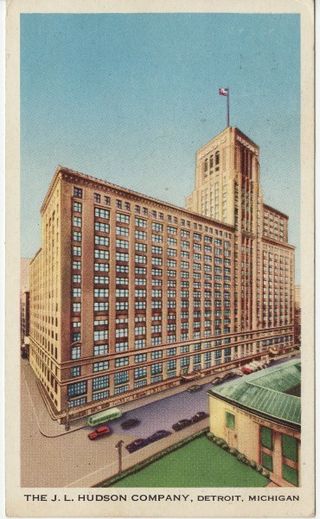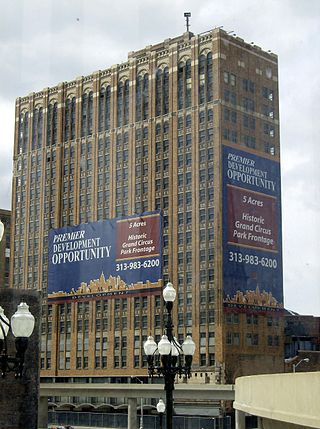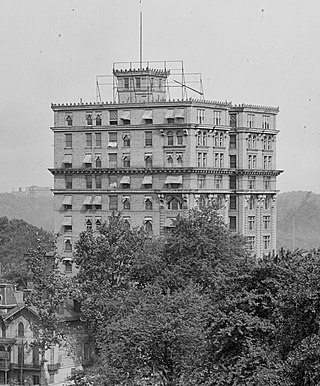
MotorCity Casino Hotel is a casino hotel located in Detroit, Michigan, United States. It was opened on December 14, 1999.

Ilitch Holdings, Inc. is an American holding company established in 1999 to provide all companies owned by Mike and Marian Ilitch with professional and technical services. Its privately held businesses include Little Caesars Pizza, the National Hockey League (NHL) Detroit Red Wings, the Major League Baseball (MLB) Detroit Tigers, Olympia Entertainment, Olympia Development, Olympia Parking, Blue Line Foodservice Distribution, Champion Foods, 313 Presents, the Little Caesars Pizza Kit Fundraising Program, Hockeytown Cafe, and a variety of venues within these entities. Ilitch Holdings subsidiaries manage Detroit's Fox Theatre, City Theatre, Comerica Park, Pine Knob Music Theatre, Michigan Lottery Amphitheater, Meadow Brook Amphitheater, and Little Caesars Arena, which replaced Joe Louis Arena after closing in July 2017.

America's 11 Most Endangered Places or America's 11 Most Endangered Historic Places is a list of places in the United States that the National Trust for Historic Preservation considers the most endangered. It aims to inspire Americans to preserve examples of architectural and cultural heritage that could be "relegated to the dustbins of history" without intervention.

The J. L. Hudson Building ("Hudson's") was a department store located at 1206 Woodward Avenue in downtown Detroit, Michigan. It was constructed beginning in 1911, with additions throughout the years, before being "completed" in 1946, and named after the company's founder, Joseph Lowthian Hudson. Hudson's first building on the site opened in 1891 but was demolished in 1923 for a new structure. It was the flagship store for the Hudson's chain. The building was demolished in a controlled demolition on October 24, 1998, and at the time it was the tallest building ever imploded.

The Detroit City Hall was the seat of government for the city of Detroit, Michigan from 1871 to 1961. The building sat on the west side of Campus Martius bounded by Griswold Street to the west, Michigan Avenue to the north, Woodward Avenue to the east, and Fort Street to the south where One Kennedy Square stands today.

The Lafayette Building was a high-rise office building located at 144 West Lafayette Boulevard in downtown Detroit, Michigan. It was built in 1923 and occupied a triangular lot, bordered by Michigan Avenue, West Lafayette Boulevard, and Shelby Street. The building was 14 floors tall, with one basement floor, and 13 above-ground floors. The office building was designed in the neo-classical architecture style by C. Howard Crane who built many of Detroit's theaters. It is built with mainly brick, limestone, and terra cotta. Its triangular form mimicked the Flatiron Building in Manhattan.

The United Artists Theatre Building is a vacant high-rise tower in downtown Detroit, Michigan, standing at 150 Bagley Avenue. It was built in 1928 and stands 18 stories tall. The building was designed by architect C. Howard Crane in the renaissance revival architectural style, and is made mainly of brick. Until December 29, 1971, it was a first-run movie house and office space, and then after that, the theatre saw sporadic usage until 1973. The United Artists Theatre, designed in a Spanish-Gothic design, sat 2,070 people, and after closing served from 1978 to 1983 as the Detroit Symphony Orchestra's recording theater. After the theater closed, the office block struggled as tenants moved to suburbs. It finally closed in 1984. An original 10-story, vertical UA sign was replaced in the 1950s with a marquee that remained until 2005. The building once shared a lot with the now demolished Hotel Tuller.

The Charlevoix Building, also known as Hotel Charlevoix, was a highrise building in Downtown Detroit. It was erected in 1905 and designed by local architect William S. Joy. The building was originally built as a speculative office building, converted into a hotel in 1912, then back into an office building again in 1922, although there is evidence that it was occasionally a mix of both.

The Detroit Statler Hotel was a building located at 1539 Washington Boulevard across from Grand Circus Park between the David Whitney Building and the Hotel Tuller in Downtown Detroit, Michigan. In addition to Washington Boulevard, the hotel also fronted Bagley Street and Park Avenue.
Eastown Theatre was a 2,500-seat theater located at 8041 Harper on the east side of Detroit, Michigan. Opening in 1931, it operated as a movie theater until being converted into a rock music venue in 1967. Performers included Alice Cooper, Emerson, Lake and Palmer, Faces, Fleetwood Mac, Grateful Dead, Steppenwolf, Cream, Pink Floyd, The Amboy Dukes and Yes.

The Eddystone Building is an apartment building and former hotel located in Midtown Detroit, Michigan, at 100-118 Sproat Street. It was listed on the National Register of Historic Places in 2006.
The Boyd Theatre was a 1920s era movie palace in Center City Philadelphia, Pennsylvania. It operated as a movie theater for 74 years, operating under the name Sameric as part of the United Artists theater chain, before closing in 2002. The theater was the last of its kind in downtown Philadelphia, a remnant of an era of theaters and movie palaces that stretched along Market and Chestnut Streets. The Boyd's auditorium was demolished in the 2015 by its owner Pearl Properties, which planned to replace it with a 24-story residential tower.

Baltimore Heritage is an American nonprofit historic-preservation organization headquartered in Baltimore, Maryland.

William Washington Hannan was a real estate developer and the first president of the National Association of Real Estate Exchanges.
Council Cargle was an American stage and film actor, whose career in theater spanned more than six decades. Based in Detroit, Cargle was described as one of the "best-known theater actors" in the U.S. state of Michigan. His film credits included Detroit 9000 in 1973, Word of Honor, a 1981 television movie, and Quentin Tarantino's Jackie Brown in 1997.

The Terrace Theatre was located at 3508 France Avenue North in Robbinsdale, Minnesota. Upon its opening on May 23, 1951, the Terrace received critical acclaim for its “bold architectural lines [and] extensive patron services.” The 1,299-seat theater, designed in the mid-century modern style by the Minneapolis architectural firm of Liebenberg & Kaplan (L&K) for movie exhibitors Sidney and William Volk, was a popular Twin Cities destination for nearly fifty years. It changed hands in 1980 and again in 1987, when it was remodeled from a single-screen auditorium into three screens by dividing the balcony. The last movie was screened in 1999 and the theater remained boarded up for seventeen years before it was demolished in the fall of 2016 to be replaced by a Hy-Vee grocery store.
Adamo Demolition is a Detroit-based asbestos remediation and demolition company founded in 1964 that specializes in industrial projects.

The Jeffery Theater is a vacant theater building at 1952 E. 71st Street, in Chicago's South Shore neighborhood.
Preservation Chicago is a historic preservation advocacy group in Chicago, Illinois, which formally commenced operations on October 23, 2001. The organization was formed by a group of Chicagoans who had assembled the previous year to save a group of buildings which included Coe Mansion, which had once housed Ranalli's pizzeria and The Red Carpet, a French restaurant that had been frequented by Jack Benny and Elizabeth Taylor. Other preservation campaigns that were instrumental in the founding of Preservation Chicago included St. Boniface Church, the Scherer Building, and the New York Life Insurance Building.

The Sun-n-Sand Motor Hotel was a motel in Jackson, Mississippi, United States. The motel was opened in 1960 and partially demolished in 2021.
















